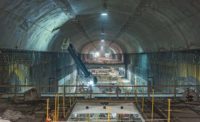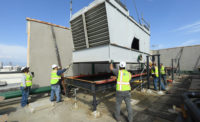ENR New York’s annual ranking of Top Specialty Contractors for 2019 revealed a decline in regional revenue compared with 2018 results. Few market sectors showed revenue growth, likely because some large companies did not participate this year. But several firms stand out with strong revenue gains—and they made strides in new areas.
The 25 companies on the 2019 list reported a 32.5% decrease in their 2018 combined revenue to $2.55 billion, compared with reported revenue of $3.78 billion in the year-ago period.
New Jersey firms experienced the biggest hit, with revenue declining 44% to $313 million among the 10 largest Garden State companies, compared with $560 million a year ago. Similarly, the 10 largest New York firms reported a 27.5% revenue drop to $1.96 billion over the same time span, down from $2.71 billion.
But there’s bright news when looking at the sectors not impacted by the nonparticipation of large firms. Sitework and excavation companies stand out, with the two largest firms reporting 15.2% annual growth to $159 million from $138 million.
Those in the electrical sector seemed to fare the worst, with that ranking’s five largest companies reporting a 24% fall in revenue to $1.27 billion from $1.67 billion. But such firms also dominate this year’s main rankings—taking the top three spots among overall respondents.
|
Related Link |
Shining Stars
E-J Electric Installation Co. moved to No. 1 in the overall ranking from No. 3 last year; took the lead spot among New York firms ranked, up from second place; and also led in the electrical market ranking, up from No. 2. The company exceeded all New York specialty contractors with $591.50 million in state revenue.
New Jersey’s leading specialty contractor, Petillo Inc., rose to No. 1 in the Garden State, with revenue of $80.27 million, climbing from third place last year. The company also moved to No. 8 in the main ranking, up from No. 15.
Petillo’s biggest strength was in the sitework-excavation-foundation category. Two of its biggest projects include the Rockefeller-Piscataway Building One, completed in Piscataway, N.J., in 2018, and the I-78 Logistics Park in Phillipsburg, which broke ground in 2018. Future New Jersey projects include American Honda’s facility in Mount Laurel, the Morristown Airport and Veronica Avenue in Franklin.
Other notable shifts from last year include L.M. Sessler, which moved to No. 1 from No. 2 in the demolition-wrecking category and rose to No. 19 from No. 28 in the overall ranking. MMC Contractors Inc. also rose—to No. 12 overall from No. 15 last year, and to No. 2 from No. 7 on the New Jersey ranking.
Cause for Growth
Ron Kollar, Petillo chief estimator, says large, complex warehouse and distribution center projects were the biggest contributor to the firm’s growth and represent its largest future opportunity.
“This is mainly due to the market shift from malls and strip malls to online shopping, and how logistics have changed to accommodate our clients,” Kollar says. “This sector of our market has also grown due to demand for faster packaging and delivery from the online market.”
Housing and large-scale public road work remain quiet, on the other hand, due to funding cooling off, he says. While interest rates remain low, the Northeast housing market remains challenged. Kollar refers to halted public roads projects as “cyclical occurrences in the market,” but he remains optimistic. “The road projects will return, hopefully in 2020. Infrastructure is always in need of improvement.”
Anthony E. Mann, E-J Electric president and CEO, says transportation and infrastructure are the company’s biggest growth areas, thanks in part to state and city agencies investing in such projects. The company’s largest regional project completed in 2018 was the CPV Valley Energy Center in Middletown, N.Y.
He also linked company growth to efficiency and improving technology. The firm uses Riskcast, a new productivity app that helps reduce jobsite paperwork headaches. Design-build helps to fast-track delivery of projects, too. About 40% of E-J Electric’s projects have been delivered this way, he says.
“By early involvement and collaboration with the owner, architect, engineer and other key trades, this method helps drastically when comparing to design-bid-build,” Mann says. Prefabrication plays another big role in expedited project delivery, he says, adding that E-J Electric just completed the country’s largest prefabricated switchgear project for Long Island Rail Road.
Challenges, Optimism
Lack of trained labor, as always, remains a challenge. Mann finds big lapses in the level of qualifications for field and office positions ranging from project managers to engineers. The company works with colleges to help educate and engage younger workers through internships, he says.
Ultimately, industry executives say they feel hopeful for a buoyant 2020. Kollar foresees two to three years of solid warehousing and distribution facility projects and a growing demand for health care facilities.
“Even though 2020 is an election year and construction seems to trend down due to uncertainty, as long as we get no major policy changes from either the state or federal governments, the market will remain strong through next year,” Kollar says.









Post a comment to this article
Report Abusive Comment